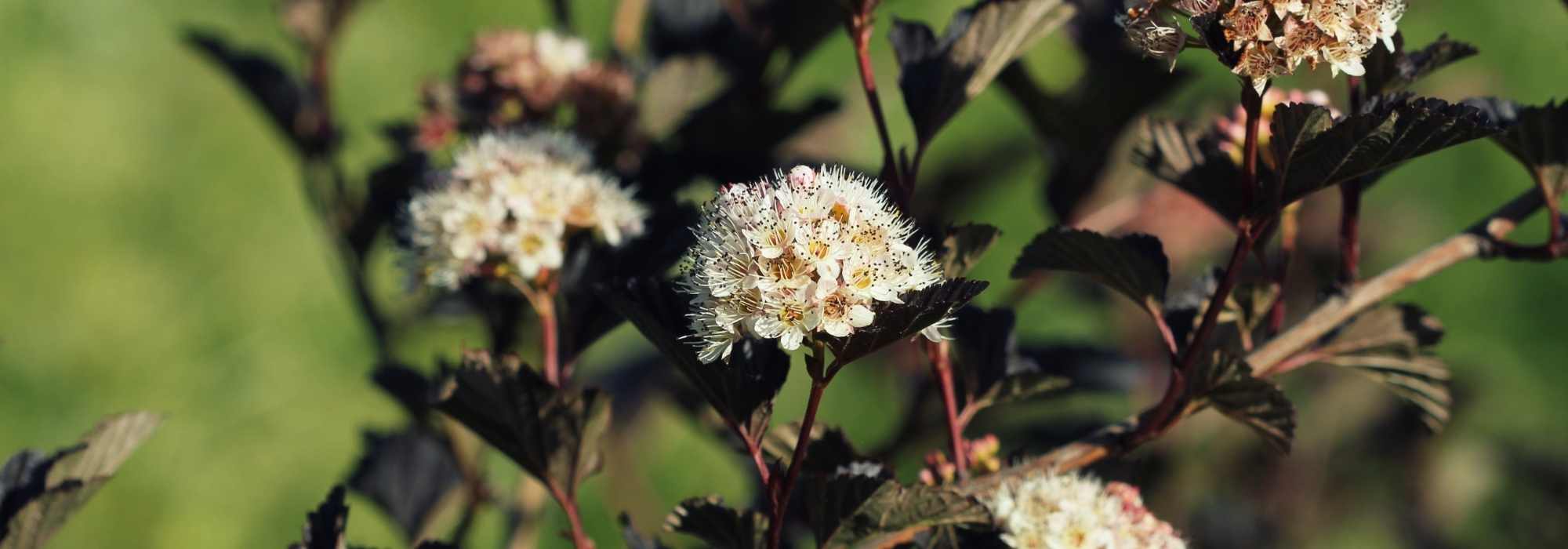
Choosing a Physocarpus
Our buying guide
Contents
Once confined to country gardens, the Physocarpus, this deciduous bush of American origin, with its charming white or pink flowering, brightens gardens in late spring. Hardy, nectariferous, fast-growing, requiring little care and resistant to diseases, it is a truly attractive and easy-going bush. In fact, it is mainly for its foliage that the Viburnum-leaved Physocarpus is planted, as once the flowering is over, it becomes a stunning specimen with the elegance of its finely cut leaves, taking on splendid hues from coppery yellow to dark brown.
Are you looking to plant a Physocarpus and unsure which cultivar to choose? Follow these few tips that should guide you in your selection!
According to the colour of the foliage
Before even flowering, it may be the colour of the foliage that guides you towards a specific variety of Physocarpus, as it has been the subject of numerous hybridizations in recent years, complementing the type species Physocarpus opulifolius with cultivars boasting stunning leaf hues. These are often dynamic, with young shoots changing colour in summer, providing a beautiful contrast against darker shades on the light corymbs. All leaves are trilobed, dentate, varying in size depending on the variety (between 5 and 8 cm).
Golden foliage
Ultra bright in spring, their leaves range from a golden yellow to a lime green. These Physocarpus should be used in partial shade rather than full sun, which they tend to avoid:
- ‘Dart’s Gold’ bursts forth with a beautiful golden yellow before turning yellow and then a reddish-brown in autumn
- ‘Angel Gold’ features acid yellow foliage that turns golden yellow, a hue it retains throughout the season, along with interesting decorative red fruits in autumn
- ‘Tiny Wine Gold’ keeps its golden leaves for a long time before they turn chartreuse green and then light green before reverting to yellow in autumn
- ‘Luteus’, one of the oldest cultivars, shines with its bronze-yellow leaves
- ‘Anny’s Gold’ (or ‘Golden Annie’): a Physocarpus with light green variegated leaves edged in yellow
 From top left to bottom right: Physocarpus ‘Dart’s Gold’, Physocarpus ‘Angel Gold’, Physocarpus ‘Luteus’, and Physocarpus ‘Anny’s Gold’
From top left to bottom right: Physocarpus ‘Dart’s Gold’, Physocarpus ‘Angel Gold’, Physocarpus ‘Luteus’, and Physocarpus ‘Anny’s Gold’
Green foliage
With green hues, the leaves of Physocarpus resemble those of snowball viburnum or currant bushes.
The type Physocarpus, Physocarpus opulifolius, also known as the obier-leaved physocarpus, has green leaves that turn bronze-yellow in autumn. They are reddish at bud burst.
The Physocarpus capitatus ‘Tilden Park’ is another atypical species, with a prostrate form used as groundcover, featuring leaves that burst forth in purple and turn green at maturity.
Orangey foliage
- ‘Amber Jubilee’: a stunning cultivar with dynamic leaves, featuring a vivid orange in spring that is particularly ornamental. It retains this hue, transitioning to golden yellow, then red and purple in summer… A “must-have” among Physocarpi!
- ‘Diable d’Or’ is considered purple, but its young orange shoots in spring that evolve to green and then purple make it one of the most beautiful. ‘Coppertina’ also transitions from orange to purple-red.
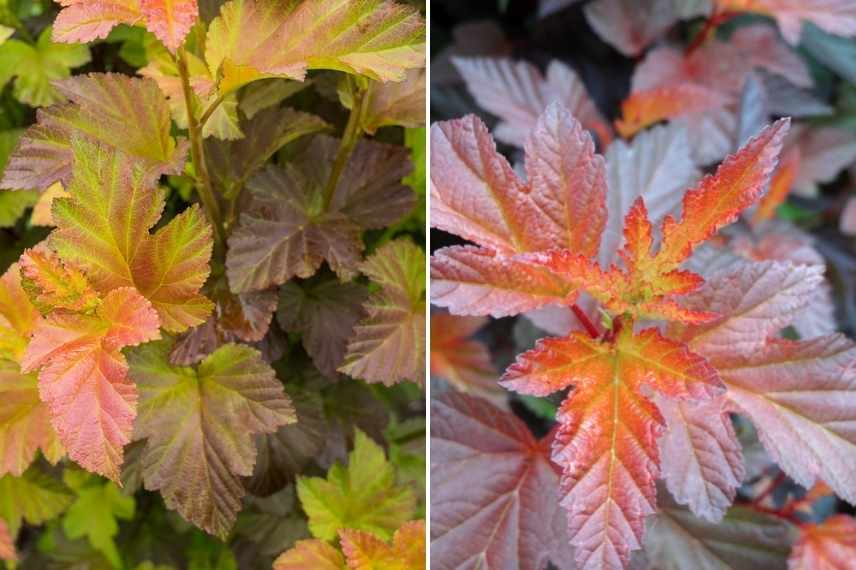 Physocarpus ‘Amber Jubilee’ (© FD Richards) and ‘Diable d’Or’ at bud burst
Physocarpus ‘Amber Jubilee’ (© FD Richards) and ‘Diable d’Or’ at bud burst
Red and purple foliage
- ‘All Black’, a very dark purple, almost black, glossy
- ‘Lady in Red’, a classic among Physocarpus, appreciated for both its upright reddish stems and its red foliage tinged with purple, orange in spring.
- ‘Diabolo’ (or ‘Diablo’) with purple stems, another highly sought-after variety for its vigorous growth and very dark purple leaves throughout summer, turning coppery in autumn, stunning!
- ‘Diable d’Or’ with foliage evolving to a deep purple in summer
- ‘Burgundy Candy’ also retains its beautiful burgundy foliage throughout summer, magical when covered in slightly pink flowers
- ‘Rubella’ stands out with ruby-red undersides to its leaves, and a lovely sheen
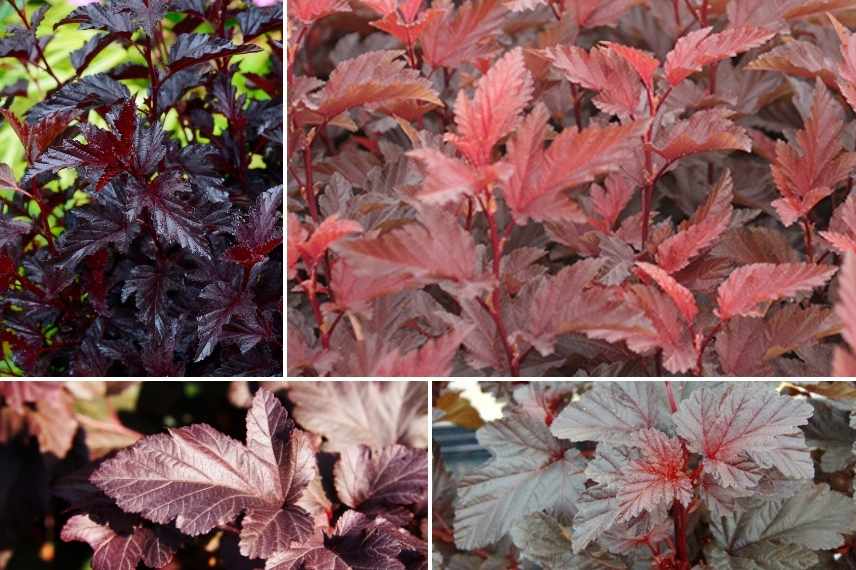 Physocarpus ‘All Black’, Physocarpus ‘Lady in Red’, Physocarpus ‘Diabolo’, and Physocarpus ‘Rubella’
Physocarpus ‘All Black’, Physocarpus ‘Lady in Red’, Physocarpus ‘Diabolo’, and Physocarpus ‘Rubella’
Brown to black foliage
They are more than just purple: almost black, a decidedly magical colour to contrast against cream to rosy flowers, and with slightly lighter shrubs. Plant purple to black-leaved Physocarpus varieties in a well-sunny position:
- ‘Midnight’ offers a superb sheen for this particularly dark variety whose pale pink flowers and red fruits further highlight the foliage
- ‘Red Baron’, quite popular among the darker varieties, with bronze to black foliage, its leaves turn coppery in autumn
- ‘Black Light’, certainly the darkest of the Physocarpus, contrasting well against white flowers
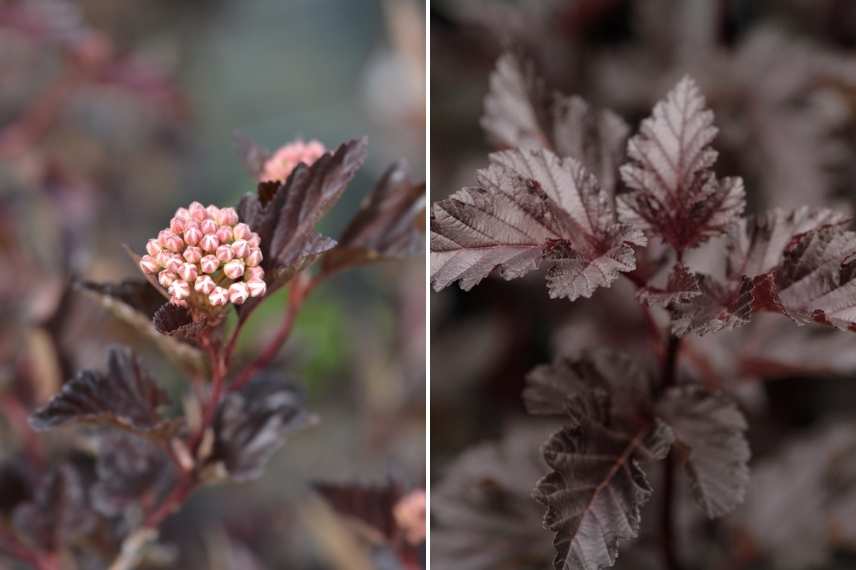 Physocarpus ‘Red Baron’ and ‘Midnight’
Physocarpus ‘Red Baron’ and ‘Midnight’
According to the colour of the flowers
Whether predominantly white or pink in certain varieties, the flowering of Physocarpus adds a great deal of charm to this shrub. It occurs between May and July, depending on the variety, in small flower clusters forming corymbs. The flower buds are often pink, or even red in some cultivars.
White flowering
The majority of Physocarpus have white flowers such as Luteus, ‘Lady in Red’, ‘Dart’s Gold’, or ‘Summer Wine’. In ‘Diabolo’, ‘Diable d’Or’, and ‘Luteus’, the flower buds are heavily tinged with red, creating a striking contrast with the bright yellow or purple foliage.
The white inflorescences are particularly highlighted against dark foliage, remaining charming and bucolic on golden to green leaves.
Pink flowering
Less common, they can nonetheless be found in ‘Little Joker’, where the slightly pink flowers harmonise beautifully with the purple foliage, as well as in ‘Fireside’ and ‘Coppertina’, both also featuring purple foliage.
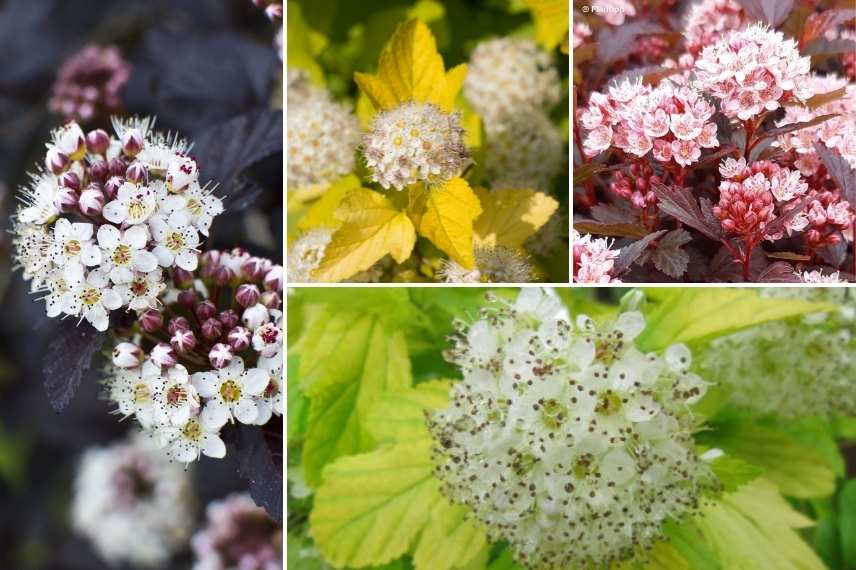
Physocarpus opulifolius ‘Diabolo’, Physocarpus ‘Tiny Wine’, Physocarpus ‘Little Joker’, and at the bottom right, Physocarpus opulifolius ‘Dart’s Gold’ (© Leonora Enking-Flickr)
Discover other Physocarpus
View all →Available in 0 sizes
Available in 3 sizes
Available in 1 sizes
Available in 1 sizes
Available in 4 sizes
Available in 2 sizes
Available in 2 sizes
Available in 2 sizes
Available in 1 sizes
Available in 1 sizes
According to its dimensions
Physocarpus are medium-sized shrubs, typically between 1.5 m and 3 m tall with a similar spread. They display a upright to erect silhouette, becoming more spreading as their branches trail down with age. Some adopt a dwarf form, ideal for planting in large pots on a terrace or urban balcony, as Physocarpus can withstand pollution well.
Large Physocarpus
The type species, Physocarpus opulifolius, as well as ‘Angel Gold’ with its golden foliage, and Physocarpus ‘Luteus’, all grow between 2 m and 3 m tall with a spread of about 2 m.
Medium-sized varieties
Physocarpus ‘Dart’s Gold’ grows up to 2 m tall and is particularly wind-resistant, making it ideal for pot planting on a terrace. ‘Diabolo’ and ‘Diable d’Or’ are also beautiful shrubs reaching 2 m tall at maturity with a spread of 1.5 m. ‘Amber Jubilee’, the orange variety, measures about 1.5 m tall, just like ‘Lady in Red’ and ‘Summer Wine’, while ‘Little Devil’ is slightly smaller, ranging from 1 m to 1.5 m in height.
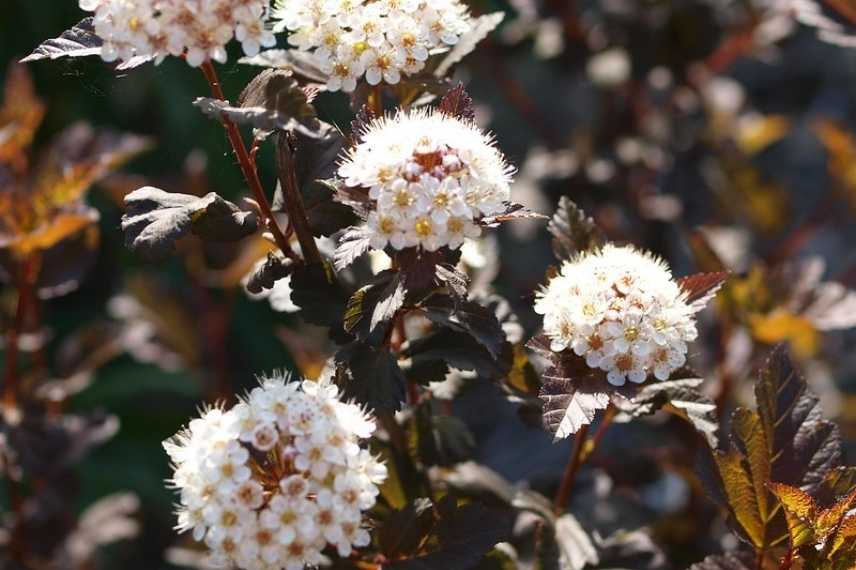
Physocarpus opulifolius Diablo or Diabolo (© FD Richards Flickr)
Compact Physocarpus
‘Tiny Wine’, the purple variety, and ‘Tiny Wine Gold’, the tangy one, both reach about 1.2 m in height, with a well-erect form; Physocarpus ‘Burgundy Candy’ with its burgundy foliage and white flowering is also perfect for small spaces, growing up to 90 cm with a spread of 80 cm.
Dwarf Physocarpus
Useful for small gardens, pots, or borders: ‘Little Joker’ is the most compact, growing from 60 cm to 1 m tall, while Physocarpus opulifolius ‘Nanus’ (or Physocarpus monogynus) with its bright green foliage grows between 1 m and 1.2 m.
Depending on the use
As a hedge
One of the key uses of our American shrub, as it grows quickly, 30 to 40 cm per year, and offers both a beautiful flowering to include in a flowering hedge, and very ornamental and colourful foliage in spring, then from summer to autumn.
For this use, consider the tallest Physocarpus mentioned above, including Physocarpus opulifolius with its vigorous growth. For a medium hedge, medium-sized Physocarpus are perfectly suitable, and you can even use dwarf varieties for small separating borders in a garden. If the shrub is deciduous, its bark, which exfoliates over the years on the thick branches, in a mahogany to copper colour, adds extra appeal, ideally planted with some evergreen shrubs like Abelia or Choisya.
 Physocarpus opulifolius
Physocarpus opulifolius
In a shrub bed
The Physocarpus is a very attractive subject for a flowering shrub bed, maintaining a colourful presence for many months, and providing delicate flowering from May to July. Physocarpus ‘Rubella’, ‘Lady in Red’ or ‘Red Baron’ can complement a range of purple foliage with a Cotinus or Sambucus nigra, for example, and pink flowers, or chosen in light tones (‘Dart’s Gold’, ‘Tiny Wine Gold’, ‘Anny’s Gold’…), green to golden, and can fit into many arrangements, alongside white, pink, or apricot sun perennials, and with other flowering shrubs like weigelas, viburnums, or berberis.
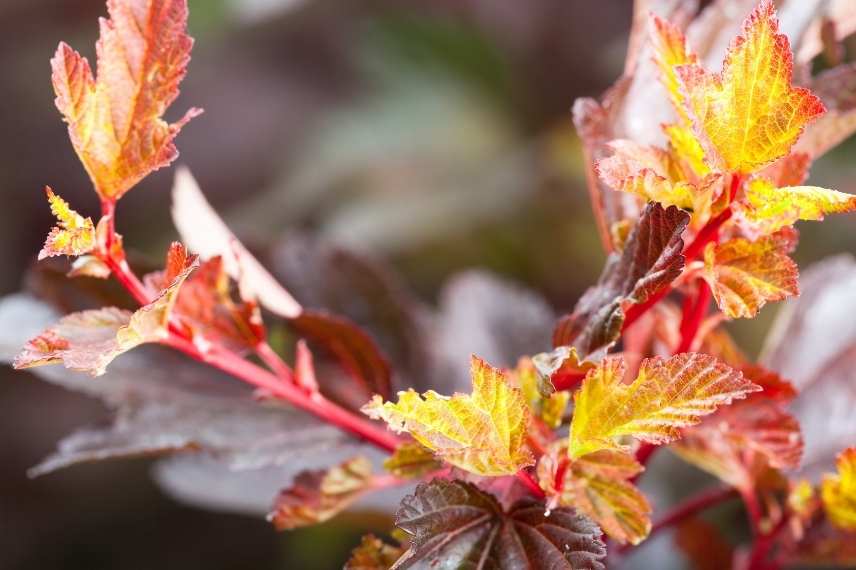 Physocarpus ‘Coppertina’
Physocarpus ‘Coppertina’
As a specimen
It is quite possible to consider planting a Physocarpus as a specimen, especially when chosen for its great ornamental qualities like ‘Amber Jubilee’, which remains modest in size and displays its orange foliage in spring, taking on golden, green, and then purplish-red hues in autumn: a marvel. A red to purple Physocarpus also makes a strong impact if planted near a pathway or the house.
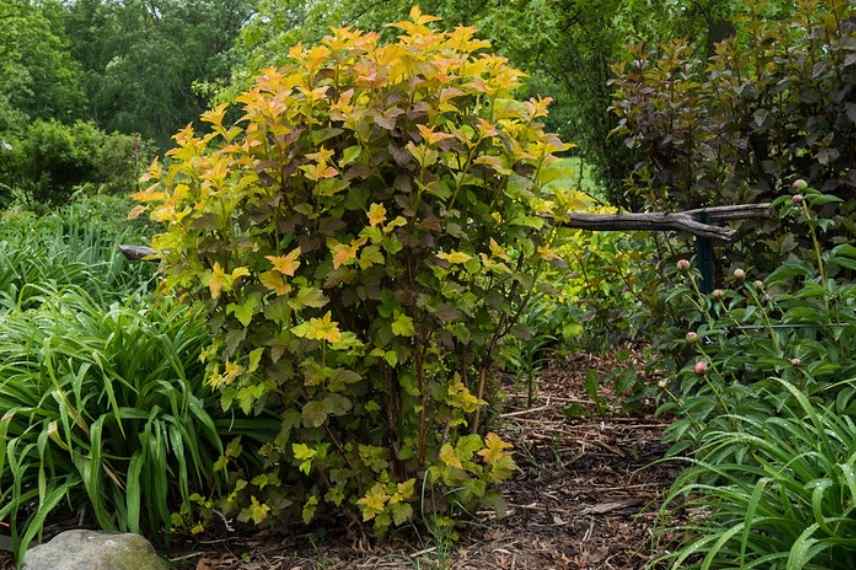 Physocarpus opulifolius ‘Amber Jubilee’ (© FD Richards)
Physocarpus opulifolius ‘Amber Jubilee’ (© FD Richards)
In a pot on a terrace
For this use, choose the most compact varieties; there are several among the Physocarpus, and they grow very well in large pots on a terrace.
‘Tiny Wine’ with its purple foliage, for example, offers a stunning contrast in small spaces. At 1m tall, it remains compact, and its white flowers tinged with pink are a delight against the dark foliage. Its green aniseed version, ‘Tiny Wine Gold’, is equally beautiful in a pot, as is a Physocarpus ‘All Black’. Another dwarf Physocarpus deserves a place on a terrace: ‘Little Devil’, which also displays dark foliage, measures no more than 1m to 1.5m. The stunning ‘Amber Jubilee’ can also be placed in a large container.
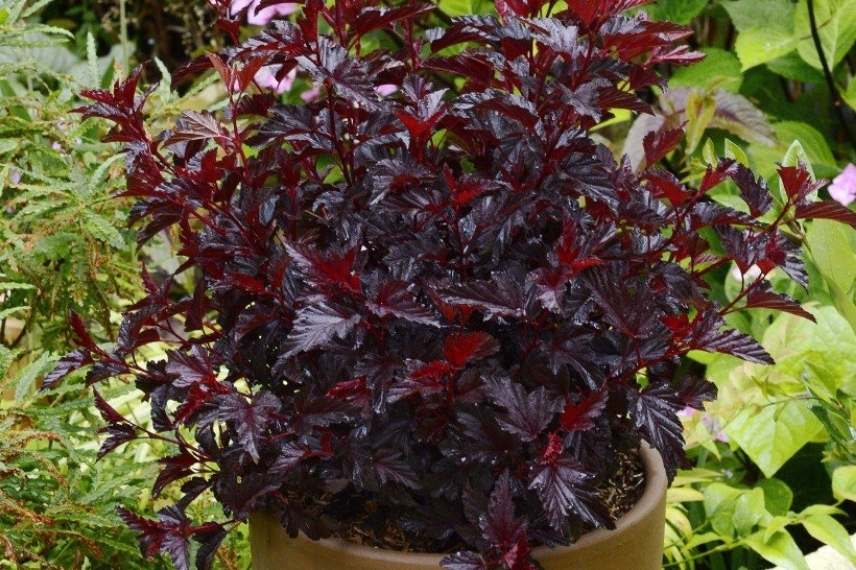 Physocarpus opulifolius ‘All Black’
Physocarpus opulifolius ‘All Black’
- Subscribe!
- Contents

































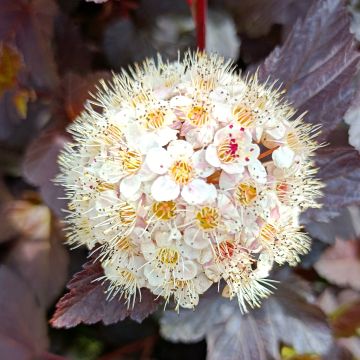
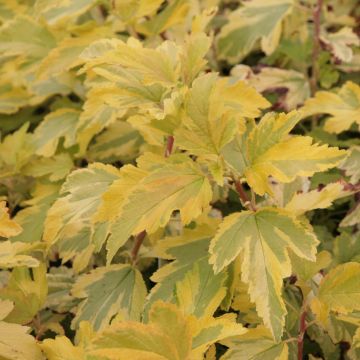
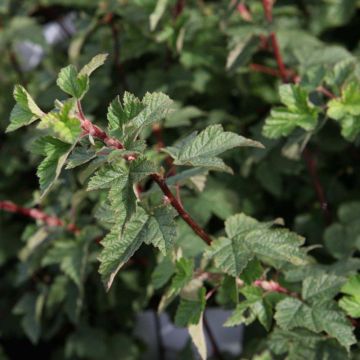

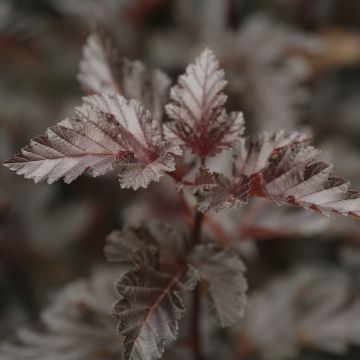

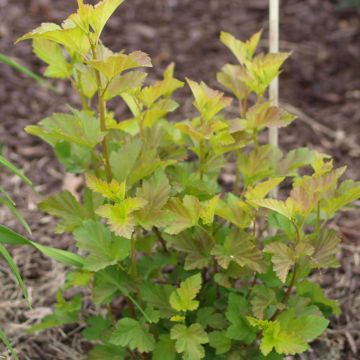
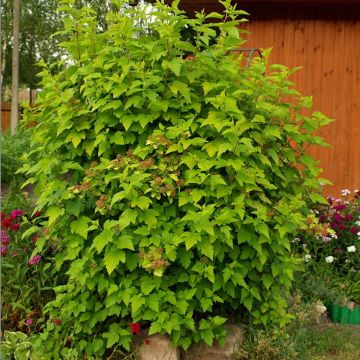

Comments